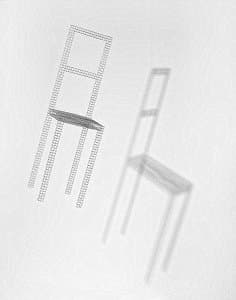

Robert Wilson
Learn moreFreud hanging chair 1977
Courtesy RW Work Ltd. Purchased 1979
More detail | PermalinkEarly in his multi-faceted career Wilson began to produce sculptures based on the principal furniture props―most often chairs―from his performance and theatre works. The suspended chair has been a recurring motif in Wilson’s work since he designed his first chair for The life and times of Sigmund Freud in 1969.[i] Freud hanging chair and Nijinsky hanging table, whose titles identify the contradiction that precludes their usual role as furniture, are constructed from wire mesh that defines the outer shell of the pieces. The mesh also gives the works a perceptible airiness that complements their suspension in space, which allows a fine elongated shadow to be cast on the gallery wall. As Michael Desmond and Ahmad Mashadi note, Wilson employs installation strategies in displaying his work, treating objects and space as a totality:
Through lighting and wall colour, spaces are conditioned to accommodate and accentuate objects and their suggested meanings. The theatrical sensibility in his art negates the neutrality of gallery spaces, allowing intimations of an unscripted psychological play.[ii]
Freud hanging chair and Nijinsky hanging table are thus a material extension of Wilson’s theatre productions, a remnant of past performances, and objects which, by virtue of being artistic works and their placement within a gallery space, have their meaning shifted by their surrounds.
Steven Tonkin
[i] The life and times of Sigmund Freud? premiered in New York in 1969
[ii] Michael Desmond and Ahmad Mashadi, Love Hotel, National Gallery of Australia, Canberra, 1997, p [15].

